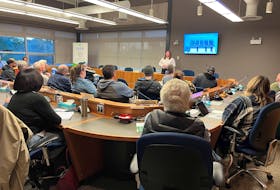AMHERST – The widow of an Amherst RCMP officer, killed while helping a motorist change a tire near Memramcook, N.B. last September, hopes his memory leads to greater awareness of Nova Scotia’s move-over law.
Savannah Deschenes, who now lives in Moncton, was in Halifax on Tuesday where interim PC leader Karla MacFarlane introduced legislation that would place signage highlighting the law on 100-series highways and mark Sept. 12 as First Responder Road Safety Awareness Day – the anniversary of when Const. Frank Deschenes was killed.
“We need to do more to educate people about the law because I don’t believe a lot of people know about it,” said Deschenes. “We don’t need a lot of signs, but we need them at key points such as where they enter the province and at off-ramps on the highways. The billboards will help because people definitely look at them.”
Her husband was killed on Sept. 12, 2017 after pulling over to help two people in an SUV change a tire. He was killed after a cargo van collided with his parked RCMP cruiser and the SUV.
She said people need to know what they’re supposed to do when they come upon an emergency vehicle stopped at the side of the road with its emergency lights flashing. Along with signage, she would also like to see the law included in the driver handbook that new drivers use.
The law, passed in 2010, requires motorists approaching stopped emergency vehicles to slow to 60 km/h and pull over to the farthest lane if safe to do so. An earlier NDP bill proposes the same law apply to tow trucks stopped at the scene of a fire or accident with its lights flashing.
“When Frank pulled someone over for not moving over they would tell him they didn’t know about the law. He would educate them and tell them to tell their friends, their neighbours and everyone they could tell. Even after his accident and the publicity that came from it I still hear people who say they don’t know about the law,” she said. “We have to keep it in the media so people are aware of it. It’s a matter of repetition and drilling it into our drivers and young children now.”
She said Frank would often tell her about how often he had to chase his hat into the ditch because of the speed vehicles would pass him while he was attending to a stopped motorist or a crash.
“He said there were times he would be picking ticks off himself because he had to chase his hat into the ditch,” Deschenes said. “He was very good at estimating how fast a vehicle was going past him and said some of them would go by him at 140 km/h.”
At the legislature on Tuesday, Premier Stephen McNeil said his government would consider the proposed changes, possibly bringing them into a single piece of legislation.
Retired RCMP officer Paul Calder is hoping the government will agree with Deschesnes. Calder was helping a motorist at the side of the highway near Amherst in November 2001 when his vehicle was struck from behind by a shuttle van on its way to Prince Edward Island.
Calder suffered a severe concussion, an injured shoulder and cuts and bruises. He was unconscious for about 20 minutes – to the point the woman who was talking to before the crash had to extricate herself from under what she thought was a dead body to get out of the RCMP cruiser and call 911 for help.
“Since the move-over law was introduced in 2010, it has not received the sustained attention it requires to make people aware,” he said. “Unless there are at least two police cars at a scene, it is very difficult to apprehend someone who violates the law and that is what leads to what some people view as ‘sting’ operations. Police officers are usually pretty busy watching out for themselves and the person who has been stopped or requires assistance.”
For people to be aware of a law, he feels, there must be a way to make it widely known. People may choose to ignore a speed zone, school zone or a construction zone, but they are not likely to miss the signs.
“Signage is very important. The Department of Transportation and Infrastructure Renewal indicated in a letter in November that research shows that signs can lead to distracted driving and sign clutter. That may be, when it comes to advertising and similar signage, but I have seen signs displayed in Alberta that are designed to get your attention through colour and design. I have heard from those who travel in the U.S. who have seen similar signs. Research may conflict with research, but in my experience, signage can play a significant part of the ability to warn and inform.
Nova Scotia RCMP officer killed on New Brunswick highway remembered as well-loved, brave
Fatal crash involving Amherst RCMP officer rekindles memories of another crash
Nova Scotians not getting the message about Move Over
Nova Scotia RCMP mourning loss of Amherst officer
Calder believes that signs should be erected at all entry points to the province and at each intersection of the 100-series highways.
In the interim and on a continuing basis, he said the electronic signs over the highways at Oxford, Debert and Miller Lake could be used more effectively to remind motorists to slow down and move over.
“Signs may not be the be all and end all, but I firmly believe they would make a difference,” Calder said.
Twitter: @ADNdarrell









